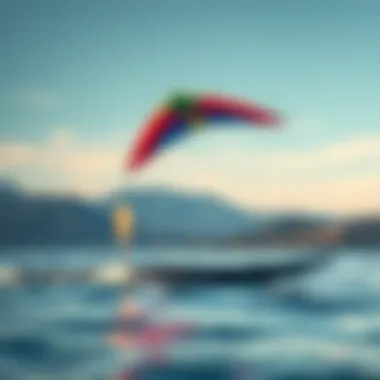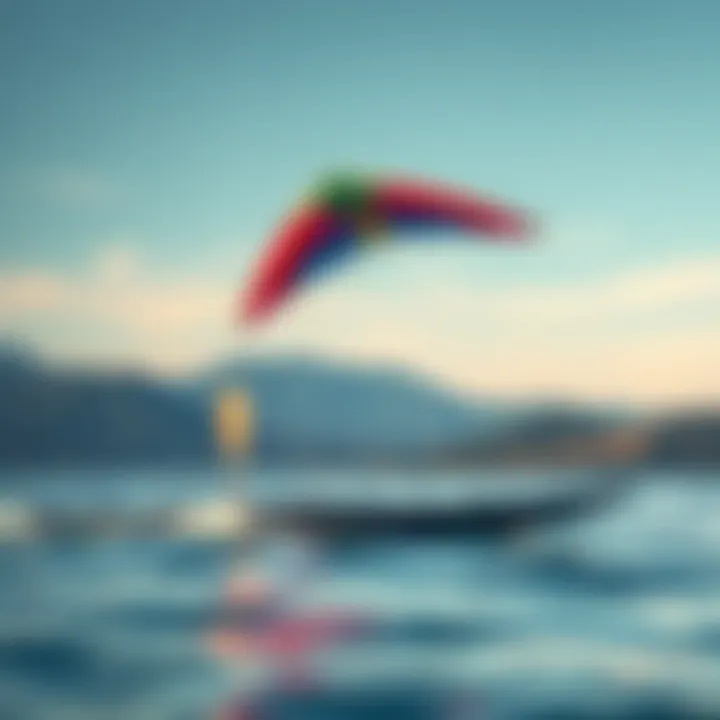Exploring the Connection Between Kayaking and Kite Sailing


Intro
The exhilarating blend of kayak and kite sailing offers unique experiences that captivate water sports enthusiasts. Each discipline has its own set of dynamics, yet they harmoniously coexist on the water, providing opportunities for adventure that are becoming increasingly popular. Navigating through choppy waters in a kayak while harnessing the power of the wind with a kite creates an unparalleled synergy that challenges and excites thrill-seekers.
Understanding the relationship between these activities not only enhances the enjoyment of each individual sport but also opens the door for new techniques, gear usage, and locations to explore. This article dives into the essential elements of both kayaking and kite sailing, exploring gear, techniques, and some must-visit spots for those eager to experience these sports in tandem. Let's paddle through the aspects that make this synergy not just plausible, but exhilarating too!
Gear and Equipment
When it comes to kayaking and kite sailing, having the right gear is vital. Each sport, while distinct, requires specific equipment that not only ensures safety but also maximizes the potential for enjoyment on the water.
Essential Gear for Kayaking
- Kayak: Choosing the right kayak is critical. There are several types such as touring, recreational, and inflatable kayaks. Beginners may find an inflatable kayak easier to manage.
- Paddle: A durable paddle should match the user's height and the kayak’s width. A lightweight material makes a significant difference in comfort.
- Personal Floatation Device (PFD): A good quality, well-fitting PFD is non-negotiable for safety.
- Dry Bags: Keeping gear dry is essential, especially on extended trips.
- Safety Kit: Reflectors, first aid supplies, and signaling devices can be lifesavers.
Essential Kiteboarding Gear for Beginners
- Kite: Start with a beginner-friendly inflatable kite; it offers stability and ease of control.
- Control Bar and Lines: The control bar is your connection to the kite. Ensure it’s appropriate for the size of kite you use.
- Harness: This connects you to the kite, freeing your hands while providing comfort.
- Board: A directional board or twin-tip board offers different styles of riding.
- Safety Kit: Just like with kayaking, a safety kit for kite sailing ensures you’re prepared for emergencies.
Advanced Equipment for Experienced Riders
As riders progress, they may wish to explore more advanced equipment:
- Larger Kites: These can capture more wind, allowing for greater heights and speed, but require more experience to manage.
- Custom Boards: Experienced kiteboarders often design their boards based on personal preferences, affecting performance and control.
- Wetsuit/Drysuit: Depending on the climate, these keep riders warm in colder water.
Techniques and Tips
Mastering the basics of kayaking and kite sailing is just the first step. Advanced techniques can elevate one’s experience and safety.
Safety Practices for Kiteboarding
- Assess Conditions: Always start by checking how strong the wind is and if there are any hazards in the water.
- Use a Leash: Ensures you don’t lose your kite when you fall.
- Learn to Relaunch: Practicing kite relaunching techniques can save you time and energy.
Training Techniques to Improve Your Skills
- Practice on Land: Getting comfortable with your equipment on land before hitting the water is helpful. It gives you a sense of control over movements.
- Watch Tutorials: Platforms like Reddit or kiteboarding forums often provide insights from seasoned riders.
- Join a Class: Consider taking lessons. Many websites like en.wikipedia.org and kiteboarding schools offer great resources.
"Combining kayak and kite sailing not only widens your skill set but also connects you deeper to nature."
By emphasizing safety, honing techniques, and utilizing suitable gear, enthusiasts can create a fulfilling blend of experiences that celebrate the best of both kayaking and kite sailing, fostering an enduring passion for both activities.
Preamble to Kayak and Kite Sailing
The expanding world of water sports brings forth a unique fusion in the form of kayaking and kite sailing. This article dives into how these exhilarating activities complement each other, providing enthusiasts with a deeper understanding of their synergy and benefits. The exploration aims to shine a light on the rich dynamics of both sports, uncovering how each enhances the experience of the other.
The Appeal of Water Sports
Water sports have long captivated adventure seekers, offering both thrill and tranquility. The appeal lies not just in the adrenaline-pumping action but also in the profound connection to nature. Kayaking allows for serene paddling through calm waters, while kite sailing brings the exhilaration of soaring over waves powered by the wind. Together, they open doors to exploration, as participants can navigate through unfamiliar waterways, discover hidden beaches, or glide across the surf, all while enjoying the beauty of the great outdoors.
The physical and mental benefits are another draw. Engaging in these activities promotes fitness, coordination, and a sense of achievement. The fresh air, the sound of water lapping against a kayak, and the unfurling of a kite in the wind create an experience that's both enriching and refreshing.
Kite Sailing and Kayaking: A Brief Overview
To grasp the synergy of kayak and kite sailing, it's crucial to understand both activities individually. Both involve unique skills and equipment, which when combined, create an exhilarating water experience.
Kayaking involves paddling a small boat, navigating personal vessels through waterways such as lakes, rivers, and coastal areas. This sport demands knowledge of paddling techniques and navigational skills, ensuring safety and efficiency on the water.
On the other hand, kite sailing, also known as kiteboarding, is all about harnessing wind energy with a large controllable kite pulled along the water's surface on a board. Riders learn how to control the kite effectively and master techniques for launching, landing, and maneuvering.
Combining these two sports can elevate the experience on the water; the flexibility in transition between paddling and riding can cater to various preferences and skills. By understanding how kayaking's calm allows for skilled kiteboarding practices, enthusiasts can immerse themselves in creative navigation challenges while enhancing their overall proficiency in both sports.
Essential Equipment for Kayaking
When stepping into the world of kayaking, having the right equipment is paramount. Not only does appropriate gear enhance the overall experience but it also ensures safety on the water. Without making your head spin, let’s break it down into some essential categories that cater to various styles and preferences. Each component serves its purpose, either to optimize your performance or to keep you safe from unexpected scenarios.
Types of Kayaks
Recreational Kayaks
Recreational kayaks are often the go-to choice for many beginners. Their design focuses on ease of use, making them a solid option for leisure paddling on lakes or slow-moving rivers. The most significant attribute of recreational kayaks is their stability. This makes them buoyant and relatively hard to tip over—ideal for those still learning the ropes of paddling.
They tend to be shorter, usually around 10 to 12 feet, making them great for maneuverability. However, while these kayaks shine in flat waters, they do have limitations in performance when you hit rougher waters. If you’re after something low-maintenance and straightforward, a recreational kayak might just be the ticket.
Touring Kayaks
Now, if you’re someone who dreams about long expeditions, touring kayaks are worth considering. These vessels are built for speed, efficiency, and covering greater distances—a must if you want to explore coastal areas or extensive lakes. A key feature here is their length, usually ranging from 12 to 17 feet. This length provides better tracking, helping you glide smoothly over the water.
Their storage compartments also allow for packing gear for overnight trips, making them popular among those looking to kayak more seriously. But as great as touring kayaks are, they can be a bit tricky to handle for novices, and their weight can make transport a chore.
Inflatable Kayaks
Inflatable kayaks have made a name for themselves over the last few years. They’re not only lightweight and portable but also convenient for those with limited storage. The unique ability to deflate means they can easily fit in the trunk of your car or even a backpack.
Their design has improved significantly, now often rivaling rigid kayaks in performance. They are generally stable but might be susceptible to punctures in sharp environments. Moreover, they require proper inflation and deflation techniques to ensure safety and performance. If versatility and transportability are high on your wish list, an inflatable kayak could be your best bet.
Safety Gear for Kayakers
Personal Flotation Devices
Nothing quite compares to the importance of personal flotation devices (PFDs). They’re critical for safety, acting as life jackets that can buy you time in emergencies. The key characteristic of PFDs is that they come in various styles, catering to specific activities and comfort levels.


A snug fit is necessary to provide adequate buoyancy and keep you safe should you find yourself in unexpected waters. Even experienced kayakers should never skip the PFD, as situations can change in a heartbeat on the open water.
Signaling Devices
When it comes to communication on the water, signaling devices can be real lifesavers. These include whistles, flares, or even VHF radios, depending on your location and the situations you might encounter. Worth noting is that some waters require specific equipment due to regulations. Having reliable signaling devices can make all the difference, especially in emergencies when you need assistance.
A simple whistle could attract attention far quicker than you might think, illustrating the need to remain diligent about your gear.
First Aid Kits
Lastly, a well-stocked first aid kit is non-negotiable. This kit should include items for treating minor injuries or ailments, from bandages to antiseptic wipes. You never know when cuts or scrapes might happen, and proper first aid can prevent small issues from escalating.
The unique aspect of these kits is their portability; they can easily fit in a kayak hold without taking up much space. Just be sure to check your kit regularly for expired items and restock as you use supplies.
In summary, the right equipment and safety gear significantly enhance your kayaking experience while keeping you safe on the water. Take your time to select the gear that best suits your style and needs!
Fundamental Gear for Kite Sailing
Kite sailing, often referred to as kitesurfing, blends the thrill of wind and water like few other sports can. To truly harness the elements, the right gear is crucial. The relationship between kite sailing and equipment goes beyond mere practicality; it encapsulates the very essence of the sport. We’ll explore the fundamental gear needed to make kite sailing not just possible, but enjoyable and safe.
Types of Kites
The choice of kite can significantly impact your experience on the water. There are several types of kites, each catering to different styles, conditions, and skill levels.
LEI Kites
Leading Edge Inflatable (LEI) kites are a mainstay in the kiteboarding community. They are primarily inflatables, meaning they stay buoyant while in use. Their key characteristic is stability, making them popular among both beginners and seasoned pros. A unique feature of LEI kites is their relaunchability; in case of a crash, they can often be relaunched from the water without much hassle.
However, they can be bulky and require careful handling when packing away. Proper inflation is also essential; a neglected LEI kite can lead to poor performance, so it’s vital to keep an eye on air pressure and overall condition.
Foil Kites
Foil kites, unlike their inflatable cousins, use air pressure to hold their shape and can be either closed (which have cells) or open. One of the most noteworthy characteristics of foil kites is their lightweight design, which makes them excellent for lighter wind conditions.
These kites are generally more efficient in terms of power-to-weight ratio, allowing for smoother ride capabilities in varying conditions. However, they don’t relaunch as easily as LEI kites, making them a choice for more experienced kiteboarders who can handle slightly greater challenges.
Hybrid Kites
As the name suggests, hybrid kites blend the traits of both LEI and foil kites. This hybridization results in versatile performance, making them suitable for a broad range of wind conditions. Their main characteristic is adaptability; these kites can offer a good balance between stability and responsiveness.
One of the unique features of hybrid kites is their design, which often incorporates inflated side strips to enhance stability and enable better wind handling. While hybrid kites can be more costly and complex in terms of setup, they provide a wonderful compromise for those looking to dabble in both light and strong wind conditions.
Safety Equipment for Kiteboarders
Safety should never take a backseat when engaging in kite sailing. Having the appropriate safety gear can make the difference between a good day out and a dangerous situation.
Harnesses
Harnesses are critical in kite sailing, as they distribute the forces exerted by the kite, allowing the rider to remain comfortable and in control. A key characteristic to consider is fit; a well-fitted harness can significantly affect maneuverability.
These come in two styles: seat harnesses, providing support from the waist down, and waist harnesses, which are better for freeriding. While seat harnesses are often preferred by beginners for their comfort, experienced riders might lean toward waist harnesses for increased freedom of movement.
Safety Leashes
Safety leashes are another non-negotiable item. They prevent the kite from drifting away if you lose control. The primary advantage of a safety leash is security; it keeps the kite within arm's reach when things go awry. However, some riders might find them restrictive if they offer too much slack during a ride.
Choosing a reliable safety leash can be a life-saver and should be regularly inspected for wear and tear.
Helmet Use
Helmets are often overlooked but should be an essential part of every kiteboarder's safety gear. The risk of head injuries, especially when riding in choppy water or high winds, makes helmet use paramount. The key feature is their protection, which cannot be stressed enough.
Additionally, modern helmets are made to be lightweight and comfortable, so they won’t hinder your performance. That said, they can be cumbersome in certain wind conditions, given that the weight can alter how you feel when navigating the waves and wind.
"Safety is not just a set of rules for kiteboarding; it’s a way of riding and respecting the sport."
Skills Required for Kayaking
When one embarks on the journey into kayaking, it soon becomes evident that having a solid foundation of skills is essential for both safety and enjoyment. These skills not only enhance your experience on the water but also serve as a bridge to effectively integrate kayak sailing with kiteboarding. Mastering paddling techniques and navigational skills ensures that whether you find yourself gliding through still lakes or battling with the wind on the waves, you are well-prepared to respond to various conditions.
Paddling Techniques
Developing effective paddling techniques is the core of kayaking. This skillset revolves around how well you use your paddle to propel, steer, and maneuver your kayak. Of course, paddling isn’t just about raw power; it’s also about efficiency and control. Here are several key elements to consider:
- Stroke Types: Familiarizing yourself with different strokes like the forward stroke, reverse stroke, and draw stroke lets you navigate various situations. Each has its own purpose, enabling you to move smoothly, brake effectively, or pull your kayak towards a desired direction.
- Body Positioning: Maintaining proper posture can make a world of difference. Keeping your back straight and your knees slightly bent allows for better movement and comfort, reducing fatigue over extended periods on the water.
- Paddle Control: As important as strength, mastery of your paddle comes from practice. Feeling the water’s resistance, adjusting strokes accordingly, and knowing when to sprint versus glide can turn a simple outing into a breathtaking adventure.
“Every stroke is a lesson; the more you practice, the clearer the lessons become.”
Mastering these paddling techniques can not only ensure a smoother experience but also becomes vital when kite sailing as you need to be adept at changing your paddling style quickly to adapt to shifting wind conditions.
Navigational Skills
The ability to effectively navigate waterways is another pillar of kayaking proficiency. Whether you're out on a sunny day or amidst unpredictable weather, being sharp in your navigational skills can mean the difference between a fun adventure and a sticky situation.
Understanding how to read a map and recognize key landmarks is foundational. It’s also crucial to have a handle on:
- Current and Tide Awareness: Rivers can carry strong currents, and tides can significantly alter conditions in coastal areas. Knowing how to read these natural forces helps in planning your route and timing your activities safely.
- Understanding GPS and Navigation Tools: In today's digital age, using GPS devices and mapping apps can provide accurate real-time data on your location and help you avoid potential hazards.
- Environmental Awareness: A good kayaker is not just a paddler but also an observer. Knowing how to identify changes in wind patterns or approaching storms can help in making smart, timely decisions.
By honing navigational skills, a kayaker not only enhances personal safety but also becomes more versatile and adventurous, paving the way for a seamless blend of kayaking and kite sailing experiences.


Ultimately, becoming adept at both paddling and navigation lays a solid foundation for those who wish to embrace the dynamic synergy between kayaking and kite sailing. The challenges faced can become stepping stones toward rewarding experiences on the water.
Kite Sailing Techniques
Kite sailing techniques are the backbone of mastering this thrilling water sport. Understanding these essential methods can significantly heighten your performance and enjoyment on the water. The techniques not only enable you to control your kite effectively but also ensure safety and efficiency as you glide across various water surfaces. As such, exploring important aspects like launching, landing, and riding techniques will equip you with the skills necessary to combine kayak and kite sailing gracefully.
Launching and Landing
Launching and landing a kite involves precision and timing. When starting, setting up the kite properly is crucial. This process requires checking the wind directions and ensuring your lines are untangled. You’ll also need to identify your launch zone, ideally free from obstacles. Once you’re ready, use your kayak as a platform — it provides stability when launching.
Landing, however, requires a smooth approach. You need to control your kite’s altitude and direction for a safe descent. Timing is everything; rushing can lead to mishaps. The better you get at launching and landing, the more confident you’ll become in your abilities on the water.
Riding Techniques
Mastering riding techniques is where the fun really begins in kite sailing. These maneuvers not only influence your performance but also your style on the water.
Tacking
Tacking involves changing direction into the wind. This maneuver expands your riding options, allowing you to explore different areas of the water while maintaining speed. A key characteristic of tacking is the need for balance and coordination when switching direction.
- Benefits: It enhances your speed control and is essential for navigating choppy waters.
- Unique Feature: Tacking can also create opportunities to build momentum.
- Advantages/Disadvantages: The advantage is it opens up more water areas to explore, but it can be challenging for beginners to execute correctly.
Jibing
Jibing, on the other hand, is when you change direction with the wind at your back. This technique generally feels smoother than tacking and can even be described as more visually appealing when executed well. A hallmark of jibing is the graceful way it allows you to maintain speed.
- Benefits: It can be less physically demanding compared to tacking.
- Unique Feature: The kite remains more stable during this maneuver, making it conducive for showing off tricks.
- Advantages/Disadvantages: The downside might be the risk of losing momentum if not done properly, but when mastered, it offers a spectacular riding experience.
Jumping
Jumping offers a sense of freedom and exhilaration that stands out in kite sailing. This technique is a thrilling blend of speed and airtime. Its defining characteristic is the sharp pull of the kite which, when timed with a wave or bump in the water, launches you into the air.
- Benefits: Jumping builds confidence and showcases your skills.
- Unique Feature: The ability to perform tricks in the air elevates the overall experience.
- Advantages/Disadvantages: The primary advantage is an enhanced adrenaline rush, but the risk lies in the landing. A harsh landing can lead to injuries, especially for inexperienced riders.
Understanding these kite sailing techniques not only enhances individual skills but also brings a community aspect to the sport. Sharing experiences about launching, landing, and maneuvering will foster connections among kiteboarders, turning a solo activity into a social adventure.
Integrating Kayaking and Kite Sailing
When it comes to blending the vitality of kayak and kite sailing, the importance of Integration cannot be overstated. In doing so, adventurers tap into the best aspects of both sports, resulting in an experience that is as invigorating as it is diverse. Kayaking teaches paddlers about water currents and navigation, while kite sailing adds an exhilarating rush that comes from harnessing the power of the wind. Thus, combining these two activities creates a rich tapestry of skills and experiences, catering to a broader range of outdoor enthusiasts.
Benefits of Combining Both
Pairing kayaking with kite sailing offers several noteworthy advantages:
- Enhanced Physical Conditioning: Both sports engage different muscle groups, providing a comprehensive workout. Kayaking is excellent for upper body strength, whereas kite sailing works your core and legs.
- Broadened Skill Set: Learning to master both activities builds versatility. Paddling skills can enhance control when kiting, and kite proficiency can serve you well on long paddles, particularly in windy conditions.
- Adaptability in Conditions: Imagine encountering windy weather while out on a serene lake. With kite sailing in your arsenal, you can suddenly turn that wind into an exhilarating ride rather than being forced to idle. This flexibility maximizes your time on the water.
- Social Connections: Integrating these two sports opens doors to a wider community. Whether meeting fellow kayakers or kiteboarders, there's a genuine camaraderie that stems from shared experiences on the open water.
Such combined benefits not only elevate the adventure but foster a harmonious relationship between the two sports, encouraging enthusiasts to explore their environments in novel ways.
Techniques for Seamless Transition
A successful transition between kayaking and kite sailing requires both skill and awareness. Here are some techniques that may help facilitate this shift:
- Master the Basics of Both Sports: Before attempting a transition, ensure you’re comfortable with foundational techniques in both kayaking and kite sailing. Familiarity breeds confidence.
- Use Appropriate Gear: Consider equipment that lends itself to both activities. Dual-purpose boards or kayaks designed for stability in kiting can simplify the process.
- Practice Under Supervised Conditions: If you're new to one or other, practice transitions while under the watchful eye of experienced instructors. This ensures safety and fosters ideal learning conditions.
- Adapt Your Mindset: Transitioning also requires a mental shift—think like a kiteboarder while paddling and vice versa. Each sport involves reading the water and wind but requires different responses.
- Utilize Designated Areas: Choosing locations that are friendly to both kayaking and kite sailing makes for an easier transition. Familiarize yourself with areas where a quick shift in activities is possible.
By honing these techniques and keeping a keen awareness of the environment, kayakers and kite sailors can smoothly navigate between the two exhilarating pursuits. As you explore diverse aquatic landscapes, integrating kayaking with kite sailing not only enhances skills but also elevates the entire outdoor adventure experience.
"The convergence of kayak and kite sailing is more than a pastime; it's a synergy that broadens horizons and enriches both mind and body."
For more insights on water sports integration, visit Wikipedia or Britannica. You can also share experiences and tips on platforms like Reddit and Facebook to connect with fellow enthusiasts.
Top Destinations for Kayaking and Kite Sailing
When it comes to experiencing the harmony between kayak and kite sailing, the right destination can elevate your adventure significantly. Each locale offers its own unique twist, shaping the interaction between the two sports and how enthusiasts engage with the environment. Finding the optimal spot not only enhances your experience but also provides a backdrop for skill-building and community interactions. This segment explores various locales that can serve as playgrounds for both activities, examining the specific traits that make them admirable choices.
Popular Kayaking Locations
Lakes
Lakes provide a haven for paddlers looking for a tranquil escape. Unlike rivers that may have unpredictable currents, lakes often feature calm waters that allow for easier navigation. One significant characteristic of lakes is their generally flat surface, which helps kayakers focus on perfecting their paddling techniques without being sidetracked by rough waves.
The advantage of a lake is its accessibility; many are situated within national parks or recreational areas, offering facilities such as launching ramps and restrooms. However, a disadvantage could be overcrowding on popular lakes, especially during peak seasons. So, you might stumble upon more folks than expected on your ventures.
Rivers
Rivers are the lifeblood of waterways, threading through towns, countryside, and wilderness alike. They're perfect for those who seek challenge and adventure. The key characteristic of rivers is their ever-changing nature, which can range from serene stretches to adrenaline-pumping rapids. This variety makes them a fitting choice for kayakers of different skill levels, ensuring there's something for everyone.
One of the unique features of rivers is their dynamic ecosystem; paddlers get not just a workout but also an up-close view of nature. However, it's important to remember that certain river sections can be hazardous, requiring paddlers to remain alert and possibly possessing advanced skills to navigate tricky waters safely.
Coastal Areas
For those who dream of combining kayaking with the thrill of the ocean, coastal areas are the ultimate destination. These venues provide a diverse kayaking experience, from sunny shores to rugged cliffs. The beneficial aspect of coastal kayaking lies in the abundant marine life; spotting dolphins or sea turtles adds a touch of magic to the outing.
On the flip side, coastal areas present challenges, particularly concerning tides and waves, which can change swiftly. Navigating such waters requires thorough knowledge of tides and weather patterns. Additionally, overcrowding can be an issue, especially around popular beaches packed during the summer months.
Best Kiteboarding Spots
Islands
Islands emerge as enticing hotspots for kiteboarding, often boasting consistent winds and stunning backdrops. Their key characteristic is the isolation that allows for a peaceful atmosphere, making them less crowded than mainland locations. This often results in ideal conditions for both novice and seasoned kiteboarders.


The unique feature of islands is the blend of flat water lagoons and open ocean, providing variety within the same trip. However, reaching some islands may require a boat ride, which adds complexity to your travel plans while also potentially elevating costs.
Windy Coastal Regions
Windy coastal regions—like Cape Hatteras in North Carolina—are ideal for kiteboarding, offering frequent strong winds that seasoned riders thrive on. The main characteristic of these areas is the reliable wind patterns, which can transform a flat day into an exhilarating ride.
Given their popularity, these locales can get busy. From beginners to pros, everyone seeks out these optimal conditions, leading to potential congestion both in the air and on the water. Riders may need to be cautious to ensure they have sufficient personal space while kiteboarding.
Lagoon Areas
Lagoon areas bring a different flavor to kiteboarding, acting as tranquil retreats with glassy waters—ideal for practicing tricks and maneuvers. The key characteristic here is the flat, sheltered waters that allow riders to push their limits safely. Because of the shallow depth, it is especially appealing to newcomers who may be wary of stronger ocean waves.
However, the disadvantage of lagoons is that they can become affected by tidal changes, impacting the water surface and making conditions less than ideal at times. Understanding local tidal schedules can be pivotal for making the most of a trip to these areas.
In summary, selecting the right destinations for kayaking and kite sailing undeniably shapes the experience, influencing skill development, safety, and enjoyment. Each spot presents its own flavors, beckoning paddlers and riders alike to explore the waterways, making the adventure as rewarding as the destination.
Safety Considerations for Both Sports
When engaging in kayaking and kite sailing, one must prioritize safety above all else. These two exhilarating water sports may share the same domain, yet they come with their own unique perils. Properly understanding safety considerations can elevate the experience, ensuring it remains exhilarating rather than dangerous. The consequences of overlooked safety can range from minor inconveniences to life-threatening situations, making it imperative that participants arm themselves with knowledge and preparedness.
Weather Conditions
Understanding the weather is crucial for anyone looking to kayak or kite sail. Each sport relies heavily on environmental conditions and knowing these can mean the difference between an enjoyable day and a potential disaster.
For kayakers, monitoring wind and water conditions is paramount. High winds can create rough waters, increasing the risk of capsizing, particularly in narrow or turbulent bodies of water. An unexpected change in weather can also lead to rapid shifts in temperature that could catch many off guard. Likewise, kite sailing is intrinsically linked to wind conditions. The kite’s performance is entirely contingent on a steady breeze—too much wind can easily overwhelm a rider, while too little means there’s no traction at all. Considering these factors, it’s advisable to check local weather reports, scrutinize wind charts, and never underestimate the power of nature.
A strong wind day could be filled with excitement for kite sailing, but for kayaking, it may pose significant hazards. Initiating a trip during the predicted pleasant weather is one thing; however, seasoned adventurers know to keep a sharp eye on weather developments throughout their outing.
"Knowledge is the best life jacket; checking the weather before any adventure can save lives and help keep the fun alive."
Gear Maintenance and Checks
This cannot be stressed enough: maintenance and regular inspections of equipment are vital. For kayakers, ensuring that the kayak is in tip-top shape includes checking for leaks, damage, and proper fittings. Inspecting paddles for splinters and the personal flotation devices for proper buoyancy are essential tasks before hitting the water.
Kite sailing gear requires similar attention. Kites should be checked for tears or frayed lines, as these can drastically alter performance or lead to accidents. The harness must fit securely without pinching and must be adjusted properly. In addition, safety systems must be functioning flawlessly to allow for quick disconnects when necessary.
It is advisable to establish a pre-gear ritual that includes the following:
- Kayak
- Kite Gear
- Inspect for leaks or structural damage
- Check paddles for weakness or breaks
- Ensure personal flotation devices fit well and are free from damage
- Assess kites and lines for frays or damages
- Adjust harness fit before use
- Test safety systems to ensure proper function
A well-maintained setup lowers the chances of mishaps and enhances performance, allowing for a smoother journey on the water. Regular checks become second nature to seasoned kiters and kayakers alike, ensuring safety is built into each outing.
Safety considerations don’t just end at the individual level; they extend to always informing friends or family about one’s kayaking or kite sailing plans, carrying communication devices when possible, and ensuring that one is equipped with adequate emergency gear. Ultimately, knowledge and preparation allow enthusiasts to embrace the excitement of these water sports while minimizing risks.
The Kayak Kite Fusion Experience
The interplay of kayaking and kite sailing creates a striking landscape where each sport complements the other. This fusion offers not just a thrilling escapade on water but also opens doors to unique experiences that challenge skills and elevate enjoyment. Exploring this synergy reveals insights into both the trials and triumphs that can arise when these two distinct activities are combined.
Unique Challenges and Rewards
With any novel combination, there are hurdles to tackle. Integrating kayaking with kite sailing isn't all smooth sailing; each sport has its own set of nuances. The primary challenge lies in mastering both disciplines simultaneously. You’ll have to juggle the skills needed for paddling while maneuvering a kite, which can feel like trying to pat your head and rub your stomach at the same time.
Moreover, there's the matter of equipment compatibility. Most folks may not think about it, but having the right kayak that can handle wind movements and the surf is essential. Not every kayak is cut out for this exhilarating blend; some are built for flat waters, which appear less suited to the windswept demands of kite sailing.
However, the rewards often outweigh the challenges. Successfully combining these sports can lead to an adrenaline-fueled adventure. Riding the wind while steering your kayak can provide a sense of freedom that feels virtually unmatched. The thrill of gliding across the water with the wind at your back, knowing that you've married the best of both worlds, creates an exhilarating liberation.
"The essence of adventure is often in the blend of the familiar with the unfamiliar."
Community and Knowledge Sharing
One of the unexpected perks of the kayak and kite fusion experience is the community it nurtures. Enthusiasts of both sports tend to be generous with knowledge, often eager to share tips and tricks. Local clubs and online forums can be treasure troves of information. Websites like reddit.com, such as r/Kitesurfing, facilitate discussions where experts and novices gather to swap stories, share experiences, and offer advice on the synergy of these two exhilarating activities.
Furthermore, workshops and meet-ups can serve as spaces for hands-on learning. Many experienced kiteboarders who have transitioned into kayaking often host sessions where they pass on their wisdom. This spirit of collaboration fosters an environment where newcomers can find guidance, making the learning curve feel less daunting.
In essence, discovering the synergy between kayaking and kite sailing isn't just about mastering techniques or mastering gear; it's also about fostering connections with others who share that same burning passion. This sense of community serves as both a support network and a source of inspiration.
In this ever-expanding world of water sports, the kayak kite fusion experience beckons enthusiasts to step beyond traditional boundaries and enjoy all that the water has to offer.
Ending: Navigating the Future of Water Sports
The synergy between kayak and kite sailing highlights a promising path for the future of water sports. With the ability to combine elements from both activities, enthusiasts can create unique experiences on the water. As the popularity of these sports rises, understanding the value of interworking techniques and equipment becomes vital.
Evolving Techniques and Equipment
The landscape of kayaking and kite sailing is continuously shifting. New techniques emerge as enthusiasts and professionals push boundaries, improving safety and performance. For instance, innovations in materials allow kayaks to become lighter yet more durable, which enhances maneuverability. On the kite sailing side, advancements in bar and line designs provide better control over the kite, accommodating varying wind conditions. Additionally, the fusion of both sports introduces specialized equipment, such as hybrid kayaks equipped with kite attachments. If you're keen on staying ahead of the curve, follow updates from reputable sources like Kiteboarding.com or dive into discussions on forums such as Reddit's r/Kitesurfing.
"The true essence of water sports lies not just in how well you master them, but also in how you adapt and innovate for better experiences."
Working to refine these techniques means embracing a mindset focused on continuous learning and safety. Engaging in community discussions can further enrich one’s skills, enhancing both personal and collective knowledge in the field. As more people share their experiences, the foundation for safer and more exciting adventures will grow stronger.
The Eco-Conscious Wave
Another important aspect to consider when exploring the future of water sports is the growing trend towards eco-conscious practices. Kayaking and kite sailing inherently connect us with nature, presenting an opportunity to advocate for environmental stewardship. More sports enthusiasts are recognizing the need to reduce their ecological footprint. This can range from using biodegradable materials in their equipment to participating in local clean-up initiatives at popular water sport destinations.
- Sustainable Practices:
- Awareness Initiatives:
- Using eco-friendly gear
- Supporting conservation efforts
- Joining community programs focused on protecting water bodies
- Engaging with organizations like the Surfrider Foundation
Sports communities are encouraged to collaborate on these sustainability efforts, creating a culture that champions both exhilarating experiences and a healthier planet. With more individuals committed to eco-friendly practices, water sports can thrive alongside nature rather than detract from it. In doing so, enthusiasts can ensure that future generations enjoy the joys of kayaking and kite sailing in pristine environments.
Moving forward, keeping an eye on innovations and sustainability in kayaking and kite sailing is essential for enthusiasts and future adventurers. The path carved by today's practitioners will significantly impact the thrill of tomorrow's experiences on the water.



